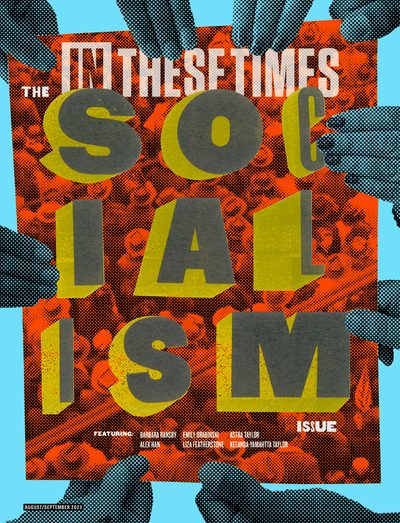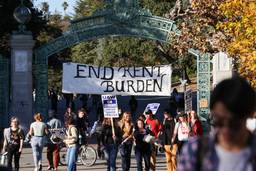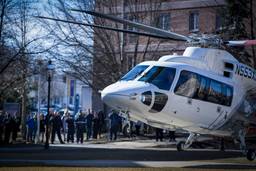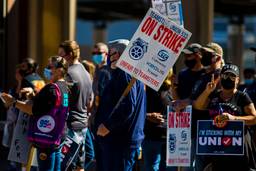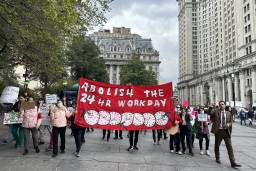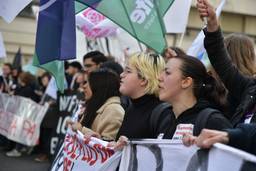Democratic Socialists Are Fueling a Hot Labor Summer
From strike support to training organizers and supporting union drives, DSA members are helping to build a fighting labor movement.
Indigo Olivier

NEW YORK — “There is a war on the working class in this country and the only way we are going to win is by building an army of organizers,” says Anthony Rosario, a former UPS driver with Teamsters Local 804. He adds: “And you’re it.”
Rosario is speaking as part of the second annual Red Hot Summer event in late June, organized by the Young Democratic Socialists of America (YDSA). More than 25,000 people tuned into the six-week labor training and political education series. The event is among a handful of projects spearheaded by YDSA and its parent organization, the Democratic Socialists of America (DSA).
Caitlyn, 23, helped organize the Red Hot Summer program in 2022 as YDSA leaders saw how much interest members had in supporting labor. “The end of the Bernie [Sanders presidential] campaign morphed into a summer salting project,” she explains. (Caitlyn is now an organizer with Teamsters for a Democratic Union.)
Salts—labor organizers who seek jobs at nonunion workplaces—have traditionally been paid by unions. Lately, DSA has been training salts on a voluntary basis as a means of growing the labor movement and making it more militant. The number of DSA members actively involved in salting has not been disclosed publicly, but a survey shows nearly 2,000 members have expressed interest and DSA has conducted more than 800 one-on-one follow-up calls.
It’s part of a long socialist tradition. Socialists were instrumental in building the labor movement at the turn of the 20th century, organizing across industries and agitating for the eight-hour workday and a minimum wage, among other now-standard U.S. labor practices. Socialists became generally less visible in organized labor after Congress expelled Communist Party members from union leadership in 1947 through the Taft-Hartley Act, and the power and ranks of unions and socialists saw a steep decline as the second half of the 20th century took a neoliberal turn, but socialists have remained invested in labor. Socialists were among the founders of Teamsters for a Democratic Union in 1976, for example.
With the recent popularity bump in labor and socialism, especially among youth, DSA is positioning itself to revive the movements hand in hand. In 2017, DSA voted to make labor a national priority and established a central labor coordinating body. Through independent fundraising efforts and the establishment of a labor solidarity fund in 2022, DSA has raised some $400,000 for local labor struggles, including for striking teachers in Oakland, Calif., and Nabisco workers in Portland, Ore.
In March 2020, DSA joined forces with the United Electrical, Radio and Machine Workers of America — among the militant unions expelled from the CIO during the Cold War under the pretext of communist sympathies — to support organizing work during the Covid-19 pandemic. The effort snowballed; as of June, the Emergency Workplace Organizing Committee is involved in 186 active campaigns and has assisted in union wins at Trader Joe’s, a Manhattan theater and a hospital in Austin, Texas, among others.
Other DSA efforts have also been involved in the wave of retail and restaurant organizing. Atulya Dora-Laskey, 24, a worker at the first unionized Chipotle restaurant, says the union victory “would not have been possible without the early guidance, resources and support” of Michigan’s Greater Lansing DSA chapter. Meanwhile, YDSA has gone campus by campus to recruit graduates into salting at union organizing hotspots like Amazon and Starbucks.
DSA also organized a national Strike Ready campaign this summer to support the Teamsters, who are now led by President Sean O’Brien, a candidate backed by Teamsters for a Democratic Union. The threat of a strike lent leverage to the Teamsters in big contract negotiations with UPS. DSA turned members out to weekly pickets and trained 238 “solidarity captains” to be on hand for a strike, while 107 local chapters passed “strike ready” resolutions. Less than a week before the strike deadline, the Teamsters announced a tentative agreement with UPS that the union says commits the company to $30 billion in spending, which includes raises, air conditioning in all new trucks and an end to the much-hated “two-tier” employment system that disadvantages new hires. (As this issue went to press, the union had not yet voted.) O’Brien credited “a credible strike threat around the country” for “the most historic contract we’ve ever had.”
DSA hopes to replicate its Strike Ready campaign with the United Auto Workers — which recently elected a slate of reform candidates to national leadership — as contract negotiations with the Big Three automakers progress.
Sean Orr, a UPS steward with Teamsters Local 705 in Chicago, says he’s seen dozens of UPS coworkers join DSA as a result of Teamster solidarity campaigns.
“I’ve talked to folks in the Teamsters since, and they still refer back to [Hunts Point] as an example of what they want to see out of allies,” Orr says. He’s referring to the 2021 strike by produce market workers in the Bronx for a $1 wage increase and sick days, led by Teamsters Local 202 and supported by more than 100 DSA members, including Rep. Alexandria Ocasio-Cortez. “That’s the kind of solidarity we need to see in our movement a lot more.”
Indigo Olivier is a reporter-researcher for The New Republic and a 2020-2021 Leonard C. Goodman investigative reporting fellow. Her writing on politics, labor and higher education has appeared in the Guardian, The Nation and Jacobin, among other outlets.
